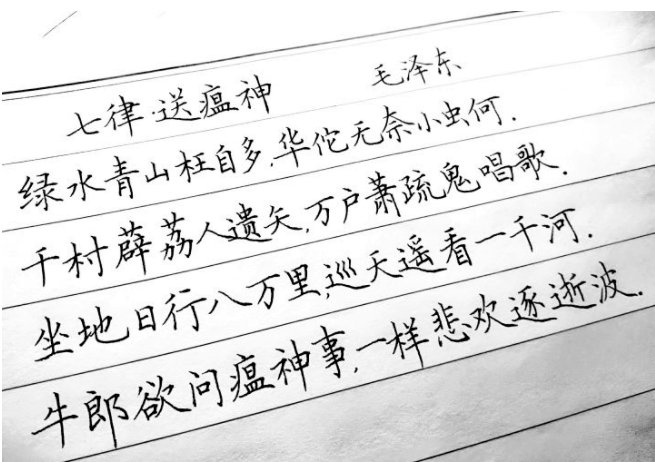Chinese characters have been passed down since ancient times and there are five mainstream common fonts [Kaixing, Li, Zhuan, and Cao]. Only Kaixing is the most common font in modern times. Before practicing calligraphy, you must first clarify your goal of practicing calligraphy. It is a lot of hard-pen writing in daily work, study and life. Or hard-pen calligraphy? These are two completely different concepts, because the aesthetic definitions are different, the quality inspection standards are different, and the basis for copybooks is also different. One is the ancient Chinese character writing system, and the other is the modern standardized calligraphy system, and they cannot be confused.

The most typical amateur performance is to ask for copybooks or fonts that suit you. There are only two directions for choosing copybooks and fonts, either professional or amateur. There are dozens of professional copybooks (styles). If you really want to practice calligraphy, you only need to consider one: Can the writer of this copybook guide me in calligraphy practice? Have you started professionally? Even amateurs teaching at the entry-level professional level are qualified. I'm afraid that amateurs teach amateurs without knowing it.
If you just recommend copybooks, then there are a lot of copybooks on certain websites or bookstores. Wouldn’t you choose them based on your personal aesthetics? There is no shortage of copybooks in this world, but there is a shortage of guidance from real professionals. I recommend copybooks to you. How many of them are professional? Can you analyze the quality of any word in two seconds and then provide reliable evidence? It can't be done. If I want to talk about it, I’m also going to tell you about my own amateur feelings, such as that it feels good and comfortable to the eyes. You feel this way too! But it is unreliable to choose copybooks with such an amateurish attitude.
There are not many copybooks on the modern market. There are thousands of copies, and there are hundreds of writers of all kinds, including amateurs and professionals. If you choose based on your personal aesthetics, you will If you choose Internet celebrity fonts, you are amateur. If you choose famous calligraphy, some famous calligraphy is actually not suitable for practice. For example, Teacher Pang Zhonghua’s calligraphy has many structural benchmark problems, but you have not studied professional introduction. Common sense, even font classification is unclear, how can you identify these?
Another thing, when practicing calligraphy, we must pay attention to [quality]. [Aesthetics] and [practicality] are actually secondary. We cannot put [aesthetics] first and raise it to a level that can solve everything. Aesthetics is It cannot solve your writing quality problem. There is no standard for good writing quality such as comfort and neatness, and there is no such quantitative standard in the comprehensive evaluation standards for your handwriting.
You say it makes people look comfortable. How comfortable is that? Can it be quantitatively analyzed? Some people started to make it up: the weather is nice and makes people feel happy, which is the first level of comfort, doing a good deed for others and being recognized and praised is the second level of comfort, and writing good calligraphy so that everyone can read and feel happy is the third level of comfort. Super comfortable, this is called making up! What is the objective basis for saying this? Have modern calligraphers taught writing in this way? The writing copybooks of mainstream modern calligraphers on the market today do not have such made-up standards.
If you make up a calligraphy practice goal based on hearsay, then when you practice calligraphy in the future, someone will definitely say that your calligraphy makes people uncomfortable. There is no most beautiful calligraphy in the world, and there is no one that makes everyone uncomfortable. Words that make people comfortable. If you define a calligraphy goal based on your feelings, in the end you will find that "pursuing good-looking and better-looking calligraphy" or "fast and good-looking calligraphy" is still amateur calligraphy practice, and amateurism means unreliability.
Let me answer my question again: where should I start from when practicing calligraphy? It should start with the most basic common sense concepts for entry into the profession, rather than starting from finding the right aesthetic direction, nor starting from finding a good-looking copybook. Asking for recommended copybooks, this is Ask those amateurs for their personal aesthetic opinions, but you have your own personal aesthetics, so why should you listen to others? You may also think cursive scripts look good, thin gold fonts look good, artistic calligraphy looks good, Internet celebrity fonts look good, your personal aesthetics may think dozens or even hundreds of fonts look good, this is called the diversification of personal aesthetics, and this is normal. But if it is used as a basis for practicing calligraphy, it is wrong and it is very amateurish. Because you can't tell the difference between professional and amateur copybooks, you won't be able to analyze the quality problems of your original handwriting and what's wrong with it. Of course you can only make random comments based on your own feelings.
So when people ask questions like ("I just started practicing calligraphy, which font is more suitable for me to practice now?"), you must start from the professional level. Practicing calligraphy is a systematic project, and it is "quality first". It is not a "beautification project". It is not about making your original ugly calligraphy look better, nor is it about practicing calligraphy to the point where everyone can I think it looks good, feels comfortable and neat, so the question is completely wrong in terms of the goal of practicing calligraphy. There is no calligraphy practice specifically suitable for students, or calligraphy practiced by workers and peasants, or calligraphy practiced by boys or girls. The goal of calligraphy practice is regardless of gender, age, education, occupation, and can only be distinguished by amateur and professional. .








